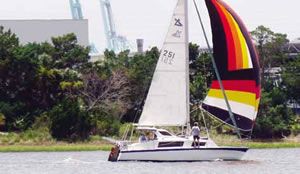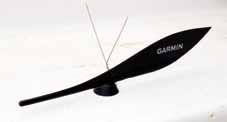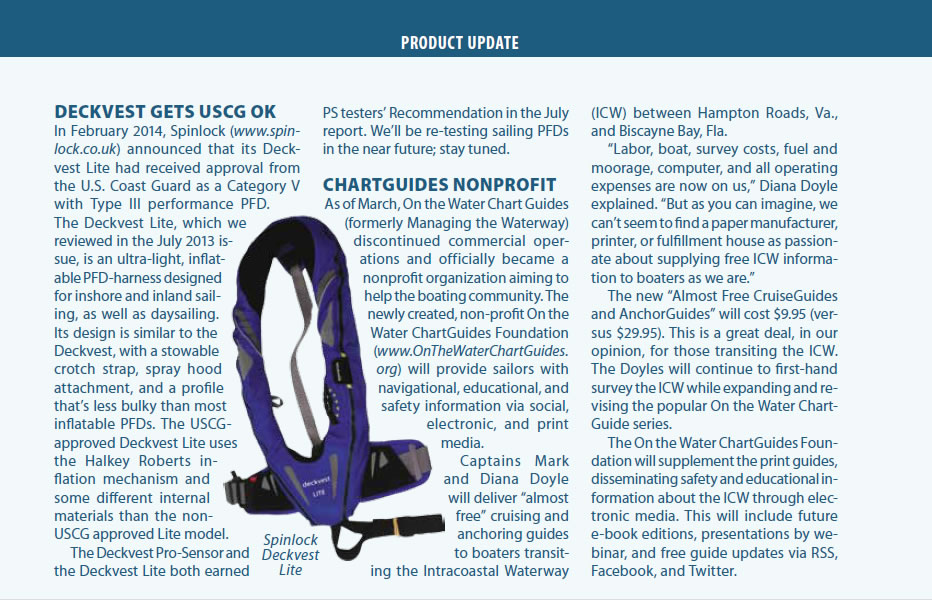Photos courtesy of Robin Leigh

In regard to the March 2014 wind instrument reviews: I installed a Garmin package, including a GWS10, a little over a year ago. The unit works well enough, but the flimsy windvane has fallen victim to birds three times.
The biggest threat to a windvane is birds, not rough weather. This applies to all models, from a simple Windex (estimated life expectancy about three months) to the old Nav5 all-metal vane.
I plan to retrofit our Garmin GWS10 wind indicator with a bird deterrent. This unit is the second replacement vane from Garmin (no charge); the first one, which had no bird deterrent, lasted only a month before being killed by birds.
Photos courtesy of Robin Leigh

The new bird deterrent will be made from an old VHF antenna and stainless fishing leader. The old antenna will overhang the vane while the fishing leader will be attached to the vane in the shape of a V, centered on the vanes axis. There is no modification of the vane itself, but others should be aware that this modification most likely nullifies the maker warranty.
Ive found that the V works well without unbalancing the vane. On our last attempt using the V on the vanes axis, the GWS10 windvane lasted about six months. A similar addition to our previous instrument, an all-metal Nav5, lasted for several years after a small initial bending.In my opinion, the V setup should be a factory feature.I will let you know how it holds up.
Robin Leigh
Vision, 1989 Gemini 3000
Jacksonville, Fla.
I found the March 2014 wind instruments review very useful, as I prepare to install all new instruments on our resurrected one-tonner. The one thing I noticed that was missing from the review was the operational range for the wireless transmitters. I have used the Tacktick system (PS, November 2009) on a 32-footer, and it worked fine, but I was told that it will not work on a 37-foot boat.
Darius Dirmantas
Via www.practical-sailor.com
Nominal range for the Tacktick is 35 feet; the Garmin gWind is 200 feet. Battery state and other factors can affect range. Well be looking closer at this topic next month. We prefer wired sensors for most cruising boats.
Regarding the Garmin GWS10 windvane (PS, March 2014), not mentioned in your review is the insecure vane attachment. The windvane is secured to the shaft with a metal clip. The clip is a slip-fit into the vane. Ive found that in any serious up draft, the vane flies off, leaving the metal clip secure on the shaft. This is apparently so prevalent that replacement windvanes are discounted on Amazon.com.
Bill Dixon
Hunter 37
Punta Gorda, Fla.
While we noted the cup attachment, the vane itself also drew our eye. The vane attaches in a similar way as the cups, and is just as fiddly to attach. It isn’t the greatest piece of design by any measure. While weve not heard of any other GWS10 vanes flying off in high winds (we will look at this closer in Round 2 of testing), reports include losing a vane while trailering at highway speeds, a bird flying away with a vane, cups lost to icing in a winter storm, and cups and vanes just falling off. We suspect the culprit in most of these cases is a mixture of marginal design, sometimes poor user assembly, and resourceful birds. We just replaced a B&G 508 that was damaged by an osprey. In our research, we could find about 15 negative reports-mostly about the cups. If anyone has found a fix to these issues, wed love to hear from them. As we said in the article, if you like the Garmin system, the more robust gWind is the best choice. We suspect that the GWS10 vanes will soon be discontinued and replaced by these twin-fin, impeller-type sensors, which earned high marks in our test.
I have been a Practical Sailor subscriber for some years, and I don’t write letters to the editor often, butI did note a statement in the March 2014 propane article with which I disagree. The article mentions using Teflon tape and thread sealant and states that using both is counterproductive. While outfitting my boats water and propane systems, I asked my plumber whether I should use Teflon tape or the thread sealant, since he sold both of them. His response: If you are like me and make 10,000 joints a year and don’t want any of them to leak, I use both. So I did as he advised. Now, years and a circumnavigation later, not a joint thusly fitted has leaked.
I have used PSs advice too many times to count-the best examples being the LaVac head, the Brunton Weil Autoprop, and the WH Autopilot. Some of the worst head issues Ive had were replacing the flap and joker valves in the LaVac while sitting upright on top of the stool. My Robertson Simrad autopilot, which I had professionally installed in New Zealand, was trash before I got to the Suez Canal, but the WH Autopilot I installed thousands of miles before our circumnavigation is still bulletproof. The Autoprop enabled me to motorsail extremely efficiently so that whenever our speed dropped below 6 knots, we motorsailed but we never had to conserve fuel.
Dr. H. Andrew Cserny
Gold Eagle, 42-foot Cross trimaran
Raleigh, Ill.
Its always great to hear field reports from readers. The pipe dope/tape discussion is one of those age-old arguments that fires the passions of plumbers around the world, and there will always be arguments as to which method works best. Indeed, there is no hard and fast rule, and using both together has, as your experience shows, worked for decades in many scenarios. Some industry professionals will say use both tape and sealant (a throwback to the days before sealing tape was made of Teflon and was not as reliable), but just as many (including our own LPG expert Capt. Frank Lanier) think its not only a waste of time, but is counterproductive. Teflon tape is more of a lubricant for the joints to go together more easily and tightly, while pipe dope is more of a sealant. Using them both is like putting glue over plastic food wrap. The tape can prevent the sealant from sealing on the threads properly, and the dope works against the tape in fighting friction. There are also those that say that when using both, the Teflon actually wipes away the dope when threading the fittings together. Plumbers may use both in water lines to try to seal a fitting with a bad spot in the threads, but for gas, youd want to simply replace the fittings. Bottom line: As long as the fitting passes a pressure test of 5 psi (per the American Boat and Yacht Council), then its good to go, whether you use one, both, or none.
This is in regard to the February 2014 article, Anchor Rode Report. I have more than 100,000 miles of offshore cruising under sail and am the author of Outfitting the Offshore Cruising Sailboat (PS, July 2012). Here are some of my observations from a dozen hurricane anchor incidents.
When it comes to anchor chain, not much is needed except when anchoring in a good blow, poor bottom, or tropical storm conditions. Fishing boats (60 to 80 feet LOA) routinely anchor quite comfortably in hurricane conditions in the shallow Bering Sea with 1,000 feet or more of half-inch chain and 100- to 200-pound anchors. Its the weight of the chain, not the weight of the anchor that guarantees survival. Similarly, one can get by with a wide assortment of anchors save in a tropical blow. We have bent a CQR in storm conditions and severely damaged a 55-pound take-apart popular alloy anchor. But the venerable ones, our Bruces, have never been damaged during hurricanes. Weve consistently used 110- and 60-pound Bruces with 400 and 200 feet of 3/8-inch high-test chain during tropical storms without failure.
Its not often realized that chain stretches under load and can break under shock loads well below its designed rating. For example, when anchoring a 45-foot, 22,000-pound centerboard ketch in shallow water in Onset Harbor, Cape Cod, during Hurricane Bob, some 200 feet of new 3/8-inch, U.S. made, G-4 alloy chain rated at 16,000 pounds stretched 10 percent, or 20 feet. We later calculated the loads at about 8,000 pounds. We were well protected from surf, and the 45-pound CQR buried itself 30 feet into the soft bottom. We replaced the chain.
Similarly, its often not appreciated that one will need one size larger shackles even when using best-grade stainless to match the alloy chains rating. And, that the large cast or wrought-iron large shackles typically found on anchors are rated well below the chains rating. However, one can with some diligence obtain rated load shackles from industrial supply houses of sufficient load. These rated shackles are typically not galvanized so they need to be kept painted. When buying shackles, the name matters greatly. No-name shackles have cost many a boat dearly in the Caribbean and elsewhere.
The real argument for chain versus wire or line is that chain is virtually indestructible if properly sized and made by a known manufacturer and that by its weight, it forms a catenary that greatly eases the vertical motion both on the boat and the buried anchor. At 1.5 pounds per foot, the common 3/8-inch, high-test chain weighs about 300 pounds for 200 feet. However, theres no need to carry all the chain forward. A neat trick is to keep 50 to 75 feet in the bow and then lead the remainder well aft. Even when we carry 400 and 200 feet of chain for our primary and secondary anchors, almost all the chain is carried well aft. After all, most times we do quite well with one anchor and just 100 feet.
Three further thoughts. In a real blow, two anchors set out in a V are required to deal with sailing at the anchor. Second, its good practice to always set the anchor at full throttle in reverse to make sure its holding solid. For some reason, storms almost always come at night. Lastly, experienced mariners routinely put the engine in gear to take the load off the chain during a real big blow. If theres only one anchor and it lets go when the wind is howling, the engine wont help much-all the more reason for having two anchors at the bow ready to go. Those anchors should be big enough with enough chain to hold in a tropical storm. Of course, most of us will never have to anchor in a tropical storm, but it is reassuring that once properly set, theres always a good nights sleep awaiting.
Peter I. Berman
Norwalk, Conn.
In regard to the recent Mailport letter about making your own rescue magnet for retrieving dropped parts and hardware: I have found the best source for free magnets are the magnetrons out of a scrap microwave ovens, and magnets out of scrap computer hard drives.
Vic Lucas
Via www.practical-sailor.com
Could you recommend an LPG sniffer? Has Practical Sailor reviewed any?
Reuben Mezrich
Via www.practical-sailor.com
We have not reviewed any LPG sniffers, but a test is in the works. It will be part of our upcoming series on LPG systems; stay tuned. If your needs can’t wait for our report, two LPG-sensor makers worth checking out are reliable supplier Trident Marine (www.tridentmarine.com) and Fireboy-Xintex (www.fireboy-xintex.com), maker of our top pick CO sensor (PS, December 2005).
I am interested in your comment about the bolt-together design being more useful to shippers than cruisers. We are new to sailing keelboats and using any anchor, so that made me wonder. Space being at a premium, it seems on the surface like it would store more easily that way.
David Swartz
Via www.practical-sailor.com
The bolt-together design is handy for those who plan to use the anchor as a backup (or storm anchor). As we mentioned, a disassembled anchor stored belowdecks doesn’t do much good. Coastal cruisers and those on short passages would do best to have a secondary and primary anchor at the ready. For those embarking on a long, offshore passage when anchoring is impossible for several days, or those relying on the anchor as a spare, the bolt-together design can be a bonus.
In regard to your August 2013 blog on combatting onboard toilet odors: I suggest trying one cup of Calgon water softening liquid, one cup of HD non-sudsing liquid detergent, and one cup of water. Mix these in a translucent water bottle, then flush down the toilet. The HD detergent controls bacteria. The Calgon keeps the contents of the tank from adhering to the sides. Always pump the tank when it is completely full, and flush with at least one tank of clean water. We have been using this method for several years, and it works great.
Bruce Schwaegel
Via www.practical-sailor.com
After fighting head odors on two production sailboats for many years, I recently decided that the best way to eliminate odors was to eliminate the toilet. I replaced it with the Cleanwaste system, which most hikers now use to pack out their waste in regulated national parks. (See www.cleanwaste.com.)
I think that Practical Sailor should look into this product and mention it to other readers. Having used this system for five seasons now, I cannot imagine why anyone would want to deal with all the issues that are required in order to bring the look and feel of land-based toilets to the marine environment. It is almost as absurd as carrying a toilet in a backpack.
David Moncton
Via www.practical-sailor.com







































